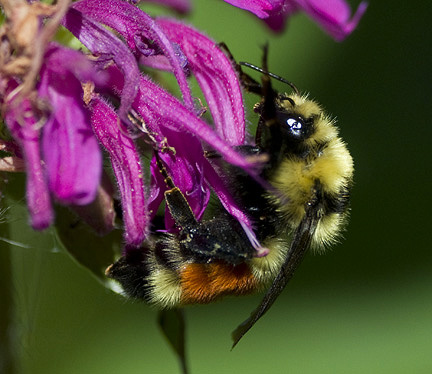Classification

Scientific Name: Bombus ternarius
Common Name: Tricolored Bumblebee
Origin of Common Name
The common name for this insect comes from its unique coloration.
Unlike most bumblebees that only have black and yellow bands, the tricolored
bumblebee has an orange band around its abdomen that distinguishes it from
other species.
Latin Origins
The family and subfamily names come from the Latin ‘Apis’ meaning bee.
The genus name, ‘Bombus’ means buzzing in Latin, and ‘Ternarius’ comes from
the Latin word meaning three parts.
Domain: Eukarya
Bombus ternarius is classified as a eukaryote because it has a true nucleus
and organelles bound in a nuclear membrane.
Kingdom: Animalia
B. ternarius is also classified in the kingdom animalia. This is
because it shares unifying features with other animals such as being
heterotrophic, relying on other organisms for food, and having a
multicellular body. B. ternarius is made of many cells, but these
cells have become specialized into tissues and also into more complex organs
and organ systems. The cells in these organs have developed to perform
specific functions necessary for the survival of the animal.
Phylum: Arthropoda
The phylum arthropoda has many defining characteristics, all of which can be
seen in B. ternarius. First, all arthropods have paired, jointed
appendages. They also have segmented bodies. Aside from these
two characteristics, all arthropods have an exoskeleton composed of chitin,
a tough outer shell that protects them from the outside world.
Class: Insecta
The tricolored bumblebee is classified as an insect because it has 3 pairs
of jointed legs, an exoskeleton, compound eyes, antenna, and a body that is
divided into three sections, the head, the thorax, and the abdomen.
Insects are the most diverse and successful group of animals on the planet
today, with over 200 million insects for each human alive. Their great
success and diversity can be attributed to the many forms and functions that
their exoskeleton can take on, making it possible for them to survive in
almost any habitat on the planet.
Order: Hymenoptera
Bees, along with ants, sawflies, and wasps, are classified as hymenoptera
because of their wings. ‘hymen’ is derived from ancient Greek word for
membrane and ‘pteron’ comes from the word for wing. Hymenoptera have
two pairs of wings and also have well developed mandibles and a proboscis
that they can use to get to the nectar that nourishes them.
Family: Apidae
The tricolored bumblebee is a part of the family apidae along with many
other bees including honey bees, carpenter bees, orchid bees, stingless
bees, cuckoo bees, and all other bumble bees. Bees are well known for
their role in pollinating and creating honey and beeswax.
Genus: Bombus
The tricolored bumblebee can be classified in the genus Bombus because of
the long setae (fuzz) on their body along with the bands of color along
their body. Typically these bands are black and yellow but some
species have red or orange on their body. Bombus can best be separated
from other fuzzy bees by the form of the female hind leg. It has a
smooth section and a ring of fur for carrying pollen.
Species: Bombus ternarius
The tricolored bumblebee can be classified as Bombus ternarius because of
its three pairs of jointed legs, exoskeleton, paired membranous wings, fuzzy
body, legs for carrying pollen, and an orange stripe on their abdomen.